Downstream Processing Market Size
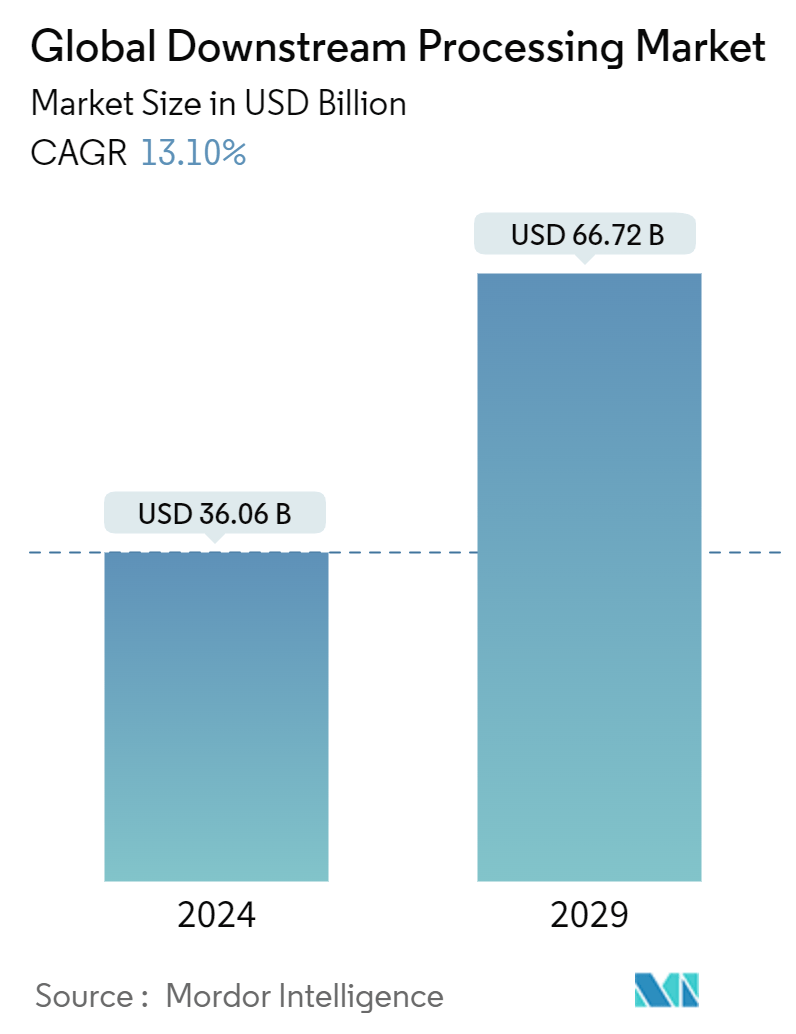
| Study Period | 2019 - 2029 |
| Market Size (2024) | USD 36.06 Billion |
| Market Size (2029) | USD 66.72 Billion |
| CAGR (2024 - 2029) | 13.10 % |
| Fastest Growing Market | Asia Pacific |
| Largest Market | North America |
Major Players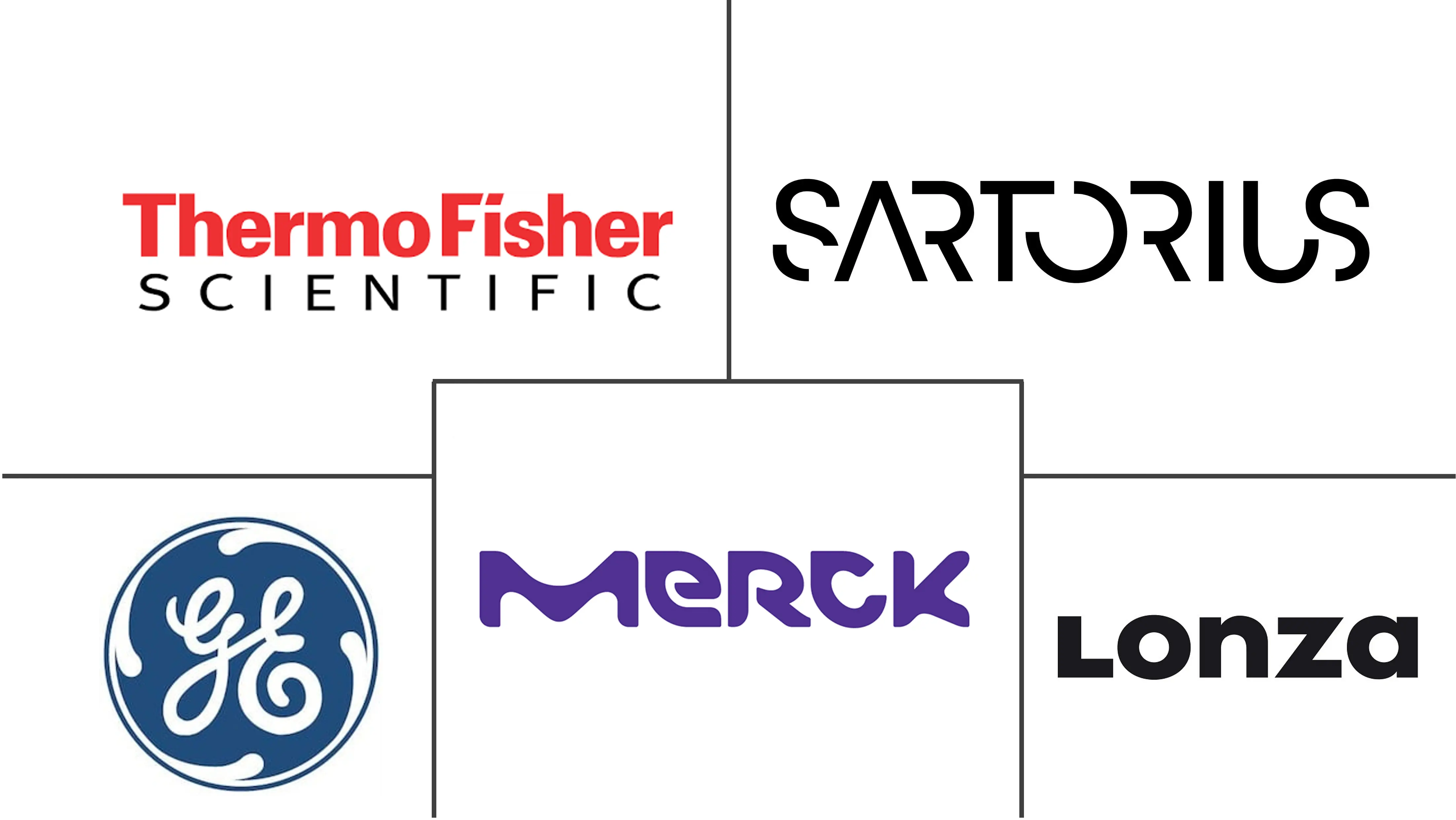
*Disclaimer: Major Players sorted in no particular order |
Downstream Processing Market Analysis
The Global Downstream Processing Market size is estimated at USD 36.06 billion in 2024, and is expected to reach USD 66.72 billion by 2029, growing at a CAGR of 13.10% during the forecast period (2024-2029).
The initial phase of the pandemic has had a substantial impact on the growth of the single-use bioprocessing market owing to the significant decline in manufacturing processes and restricted demand and supply of drugs. With the increasing number of COVID-19 cases, the demand for effective drugs and vaccines were increased which has increased the adoption of downstream processing systems and technology by biopharmaceutical companies due to fewer chances of contamination and reduced sterilization tests between the batches. This impacted the market growth during the pandemic.
The factors attributing to the market growth are the increasing demand for the biotechnology sector globally, rising research and development expenditure in biopharmaceutical companies, and an increase in the prominence of contract manufacturing companies.
With the increasing pharmaceutical spending on research and development, adoption of various business strategies, and advanced technology, downstream processing is being increasingly adopted in the biopharmaceutical industry, boosting market growth over the forecast period. According to the data published by the Congressional Budget Office, in 2021, it has been observed that pharmaceutical industries have spent nearly USD 200 billion on research and development in 2020 globally compared to USD 83 million in 2019. Thus, the increasing investment in research and development by the companies further increases the capabilities of the company to adopt innovative bioprocess technologies, resulting in the adoption of continuous downstream processing systems for multicomponent separations, perfusion chromatography systems, high-throughput process development, and high-resolution membrane systems, thereby increasing market growth.
Several advantages offered by downstream processing, such as high efficiency, reduce costs, and generally dominated by chromatographic separations and membrane filtrations are also contributing to the market growth.
Also, the rising utilization of filters in assessing viral inactivation is expected to increase the market growth. For instance, according to an article published in May 2020, titled 'Approaches to Purification, Analysis, and Characterization of Antibody-Based Therapeutics', it has been observed that the final two steps of downstream processing for antibodies often involve the two fundamental biopharmaceutical production technologies of virus filtration and ultrafiltration. Additionally, with current developments like continuous processing and increased monoclonal antibody (mAb) concentrations, virus filters have developed to better meet the needs of the biopharmaceutical industry. Furthermore, as per the same source, parvovirus-retentive filters are now utilized for the development of new mAb processes. Thus, the increased usage of virus filters in the production of antibodies and related biotherapeutics and recent advances in the use of filters is expected to increase the demand for downstream processing which in turn is anticipated to boost the market growth.
However, the high cost of instruments and purification bottleneck are expected to restrain the market growth over the forecast period.
Downstream Processing Market Trends
Antibodies Production is Expected to Dominate the Downstream Processing Market During the Forecast Period
The antibodies segment is expected to witness significant growth in the downstream processing market over the forecast period owing to the factors such as rising demand for antibiotics for the treatment of several disorders, and growing demand for monoclonal antibodies. For instance, according to an article published in August 2022, titled 'Recent Advances and Future Directions in Downstream Processing of Therapeutic Antibodies', continuous and semi-continuous downstream processes are being investigated as alternatives to batch processes due to the increased adoption of perfusion methods for antibody production. In addition, the development of downstream processes is increasingly using statistical and mechanistic modeling techniques, which allows for a deeper knowledge of chromatographic unit activities.
In addition, antibiotic resistance is on the rise, which increases the demand for developing antibodies that act against resistant strains. This is expected to increase the adoption of downstream processing in antibody production, thereby fueling market growth.
Furthermore, the rising company activities for developing products for efficient purification of antibodies are also contributing to the market growth. For instance, in January 2021, Cytiva launched HiScreen Fibro PrismA for early monoclonal antibody (mAb) purification process development. The Fibro technology uses an open porous adsorbent material made of cellulose fibers for efficient mass transfer. The Fibro technology enables rapid cycling chromatography which accelerates research and process development and boosts output in large-scale manufacturing.
Thus, owing to the aforementioned factors, the market is expected to grow significantly during the forecast period.
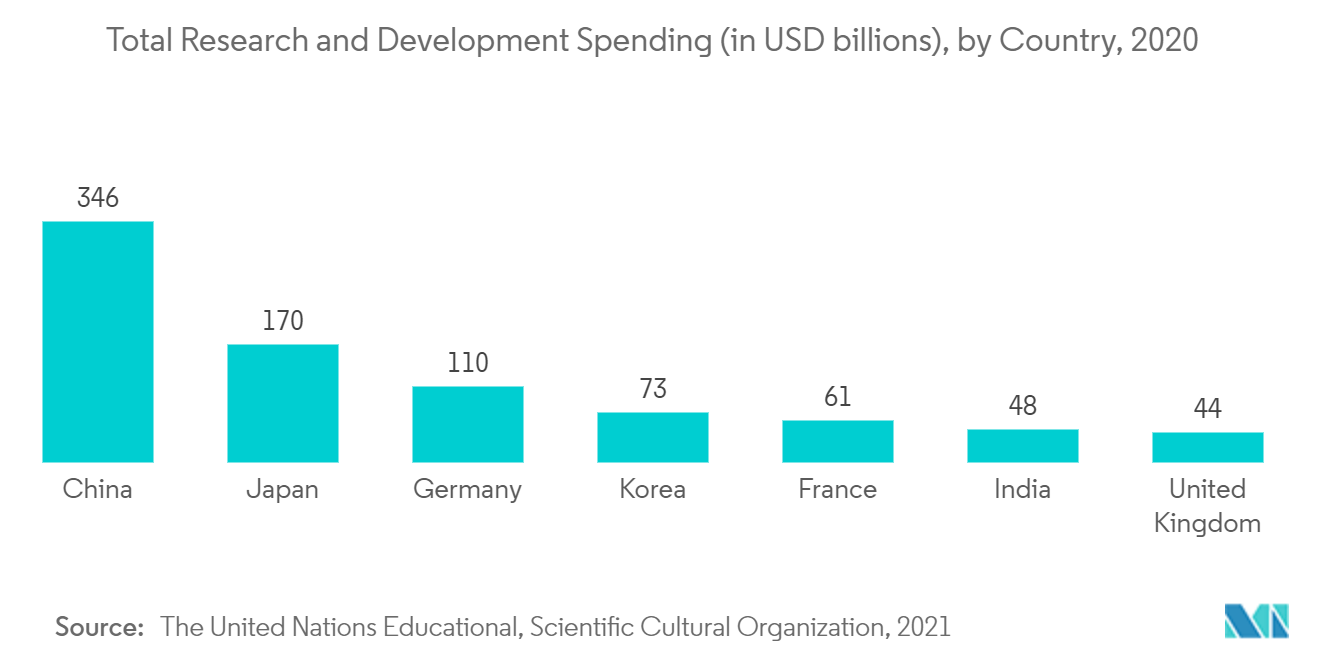
North America Dominates the Market and Expects to do Same Over the Forecast Period
North America is expected to hold a significant market share in the downstream processing market owing to the factors such as the increasing adoption of downstream bioprocessing in antibodies production in the industry, rising government initiatives in promoting bioprocess technologies, and the presence of a well-established healthcare infrastructure.
The rising government funding and investment for advancing the manufacturing process in biopharmaceutical industries are also contributing to market growth. For instance, in July 2021, the National Institute for Innovation in Manufacturing Biopharmaceuticals (NIIMBP) received two grants totaling USD 153 million from the National Institute of Standards and Technology (NIST) of the United States Department of Commerce. Also, as part of the American Rescue Plan, the National Institute of Standards and Technology (NIST) gives NIIMBL USD 83 million over three years to assist in research and development aimed at halting, preparing for, and responding to coronavirus epidemics.
The rising company activities and increasing focus on adopting various business strategies such as a merger, acquisition, and expansion of the facility to withhold their position in the market are also contributing to the market growth. For instance, in April 2022, Merck entered into an agreement with Wuxi National High-tech Industrial Development Zone. Under the agreement, Merck expands its single-use manufacturing center in Wuxi, East China's Jiangsu province. Also, in March 2022, Thermo Fisher Scientific Inc., invested USD 97 million to expand its clinical research operations in Richmond, Virginia. The facilities support increasing demand across biopharma for consistent, high-quality laboratory services to accelerate drug development. Similarly, in April 2021, Thermo Fisher Scientific launched the HyPeak chromatography system, a single-use chromatography system for bioprocessing, with significant functions in therapeutic protein as well as vaccine development.
Thus, owing to the aforementioned factors, the market is expected to grow significantly during the forecast period.
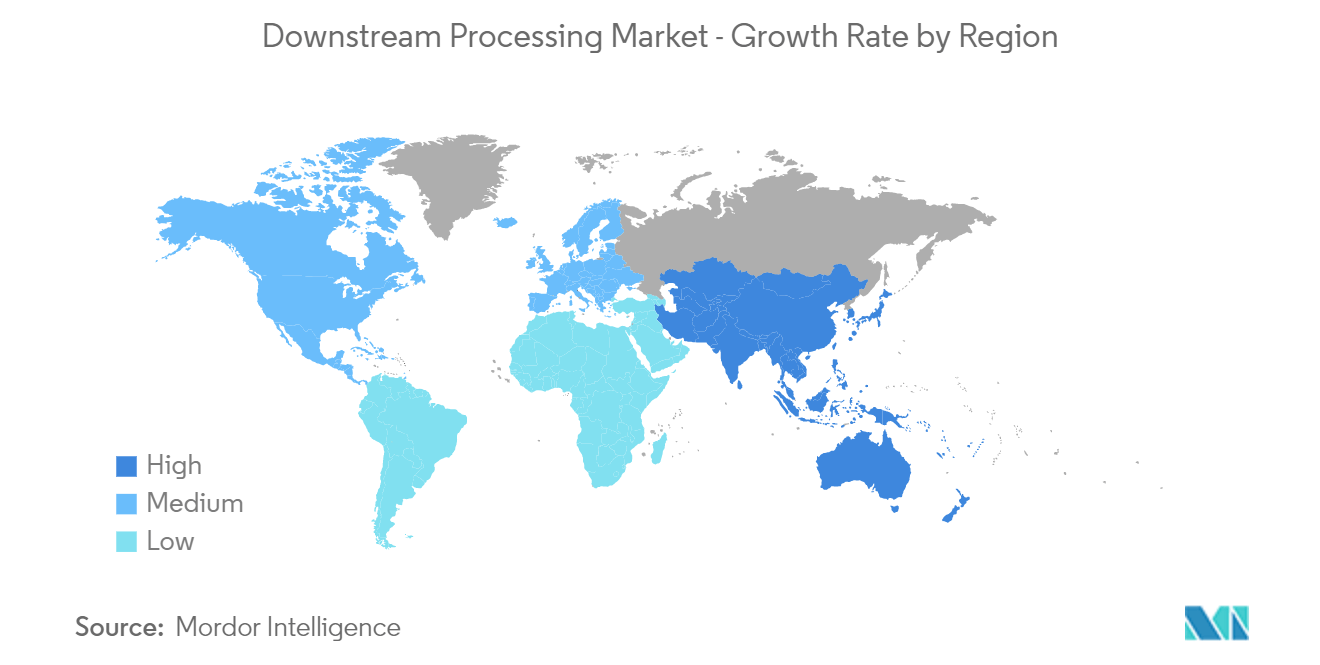
Downstream Processing Industry Overview
The downstream processing market is highly fragmented with the presence of a considerable number of companies that are significantly contributing to the market growth. The market players are investing massive amounts to transform their product lines in the market. Likewise, with varying technology the need for better technology infrastructures are rising, to cater to the need of the customers, market participants are continuously inventing new products. Some of the key players in the market are Lonza Group, Thermo Fisher Scientific Inc., Danaher Corporation, Sartorius Stedim Biotech S.A., Merck KGaA (Merck Millipore), 3M Company, and Eppendorf AG.
Downstream Processing Market Leaders
-
Thermo Fisher Scientific Inc.
-
Merck KGaA (Merck Millipore)
-
Danaher Corporation (Cytiva)
-
Sartorius Stedim Biotech S.A.
-
Lonza Group
*Disclaimer: Major Players sorted in no particular order
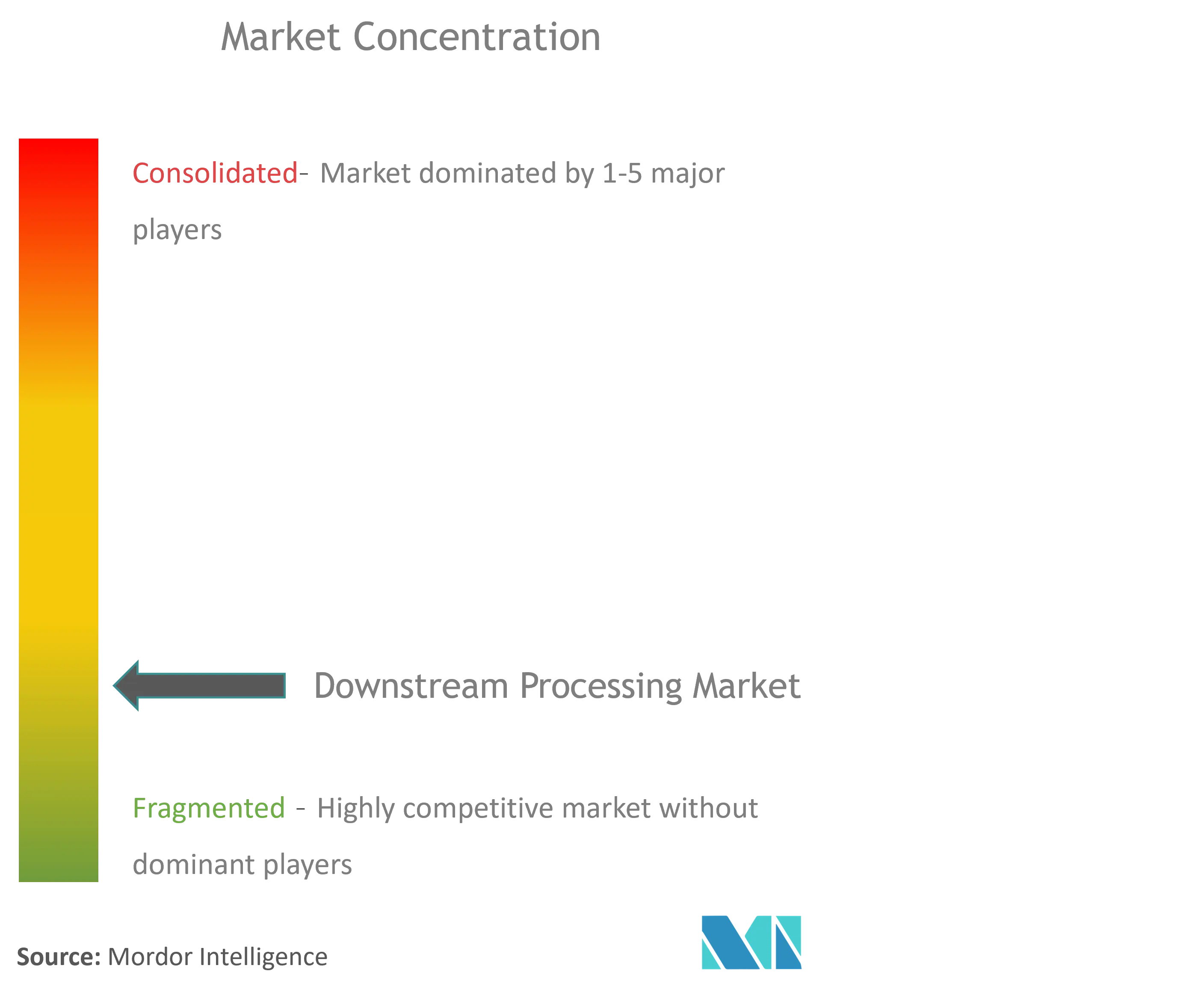
Downstream Processing Market News
- In June 2022, Merck collaborated with Agilent Technologies to reduce the industry gap in process analytical technologies (PAT) for downstream processing. Under the collaboration, the companies combine Merck's bioprocess portfolio with Agilent Technologies' advanced analytical products to extend real-time monitoring and automated process control of critical process parameters (CPPs) and critical quality attributes (CQAs) in downstream processing (DSP).
- In February 2022, Sartorius Stedim Biotech acquired the Novasep chromatography division that comprises chromatography systems primarily suited for smaller biomolecules, such as oligonucleotides, peptides, and insulin, as well as innovative systems for continuous manufacturing of biologics.
Downstream Processing Market Report - Table of Contents
1. INTRODUCTION
- 1.1 Study Assumptions and Market Definition
- 1.2 Scope of the Study
2. RESEARCH METHODOLOGY
3. EXECUTIVE SUMMARY
4. MARKET DYNAMICS
- 4.1 Market Overview
-
4.2 Market Drivers
- 4.2.1 Growth of Biotechnology Sector Globally
- 4.2.2 Rising R&D Expenditure in Biopharmaceutical Companies
- 4.2.3 Increase in the Prominence of Contract Manufacturing Organizations
-
4.3 Market Restraints
- 4.3.1 High Cost of Instruments
- 4.3.2 Purification Bottleneck
-
4.4 Porter's Five Force Analysis
- 4.4.1 Threat of New Entrants
- 4.4.2 Bargaining Power of Buyers/Consumers
- 4.4.3 Bargaining Power of Suppliers
- 4.4.4 Threat of Substitute Products
- 4.4.5 Intensity of Competitive Rivalry
5. MARKET SEGMENTATION (Market Size by Value - USD million)
-
5.1 By Technique
- 5.1.1 Purification Techniques
- 5.1.2 Solid-Liquid Separation
- 5.1.3 Clarification/Concentration
-
5.2 By Product
- 5.2.1 Chromatography Columns and Resins
- 5.2.2 Filters
- 5.2.3 Evaporators
- 5.2.4 Centrifuges
- 5.2.5 Other Products
-
5.3 By Application
- 5.3.1 Antibodies Production
- 5.3.2 Vaccines Production
- 5.3.3 Insulin Production
- 5.3.4 Other Applications
-
5.4 Geography
- 5.4.1 North America
- 5.4.1.1 United States
- 5.4.1.2 Canada
- 5.4.1.3 Mexico
- 5.4.2 Europe
- 5.4.2.1 Germany
- 5.4.2.2 United Kingdom
- 5.4.2.3 France
- 5.4.2.4 Italy
- 5.4.2.5 Spain
- 5.4.2.6 Rest of Europe
- 5.4.3 Asia-Pacific
- 5.4.3.1 China
- 5.4.3.2 Japan
- 5.4.3.3 India
- 5.4.3.4 Australia
- 5.4.3.5 South Korea
- 5.4.3.6 Rest of Asia-Pacific
- 5.4.4 Middle-East and Africa
- 5.4.4.1 GCC
- 5.4.4.2 South Africa
- 5.4.4.3 Rest of Middle-East and Africa
- 5.4.5 South America
- 5.4.5.1 Brazil
- 5.4.5.2 Argentina
- 5.4.5.3 Rest of South America
6. COMPETITIVE LANDSCAPE
-
6.1 Company Profiles
- 6.1.1 Thermo Fisher Scientific Inc.
- 6.1.2 GE Healthcare
- 6.1.3 Sartorius Stedim Biotech S.A.
- 6.1.4 Merck KGaA (Merck Millipore)
- 6.1.5 Danaher Corporation (Cytiva)
- 6.1.6 3M Company
- 6.1.7 Lonza Group AG
- 6.1.8 Eppendorf AG
- 6.1.9 Repligen Corporation
- *List Not Exhaustive
7. MARKET OPPORTUNITIES AND FUTURE TRENDS
** Subject To AvailablityDownstream Processing Industry Segmentation
As per the scope of the report, downstream processing is a part of a bioprocess that includes the recovery and purification of biosynthetic products. The downstream process is found to be an essential part of the manufacturing of vaccines, antibodies, antibiotics, and hormones, such as insulin and human growth hormone. The downstream processing thus includes five stages; solid-liquid separation, intracellular products are released, concentration and chromatography method is used for purification and formulation. The Downstream Processing Market is segmented by Technique (Purification Techniques, Solid-Liquid Separation, and Clarification/Concentration), Product (Chromatography Columns and Resins, Filters, Evaporators, Centrifuges, and Other Products), Application (Antibodies Production, Vaccines Production, Insulin Production, and Other Applications) and Geography (North America, Europe, Asia-Pacific, Middle-East and Africa, and South America). The market report also covers the estimated market sizes and trends for 17 different countries across major regions globally. The report offers the value (in USD million) for the above segments.
| By Technique | Purification Techniques | |
| Solid-Liquid Separation | ||
| Clarification/Concentration | ||
| By Product | Chromatography Columns and Resins | |
| Filters | ||
| Evaporators | ||
| Centrifuges | ||
| Other Products | ||
| By Application | Antibodies Production | |
| Vaccines Production | ||
| Insulin Production | ||
| Other Applications | ||
| Geography | North America | United States |
| Canada | ||
| Mexico | ||
| Geography | Europe | Germany |
| United Kingdom | ||
| France | ||
| Italy | ||
| Spain | ||
| Rest of Europe | ||
| Geography | Asia-Pacific | China |
| Japan | ||
| India | ||
| Australia | ||
| South Korea | ||
| Rest of Asia-Pacific | ||
| Geography | Middle-East and Africa | GCC |
| South Africa | ||
| Rest of Middle-East and Africa | ||
| Geography | South America | Brazil |
| Argentina | ||
| Rest of South America |
Downstream Processing Market Research FAQs
How big is the Global Downstream Processing Market?
The Global Downstream Processing Market size is expected to reach USD 36.06 billion in 2024 and grow at a CAGR of 13.10% to reach USD 66.72 billion by 2029.
What is the current Global Downstream Processing Market size?
In 2024, the Global Downstream Processing Market size is expected to reach USD 36.06 billion.
Who are the key players in Global Downstream Processing Market?
Thermo Fisher Scientific Inc., Merck KGaA (Merck Millipore), Danaher Corporation (Cytiva), Sartorius Stedim Biotech S.A. and Lonza Group are the major companies operating in the Global Downstream Processing Market.
Which is the fastest growing region in Global Downstream Processing Market?
Asia Pacific is estimated to grow at the highest CAGR over the forecast period (2024-2029).
Which region has the biggest share in Global Downstream Processing Market?
In 2024, the North America accounts for the largest market share in Global Downstream Processing Market.
What years does this Global Downstream Processing Market cover, and what was the market size in 2023?
In 2023, the Global Downstream Processing Market size was estimated at USD 31.34 billion. The report covers the Global Downstream Processing Market historical market size for years: 2019, 2020, 2021, 2022 and 2023. The report also forecasts the Global Downstream Processing Market size for years: 2024, 2025, 2026, 2027, 2028 and 2029.
Downstream Processing Industry Report
Statistics for the 2023 Downstream Processing market share, size and revenue growth rate, created by Mordor Intelligence™ Industry Reports. Downstream Processing analysis includes a market forecast outlook to 2029 and historical overview. Get a sample of this industry analysis as a free report PDF download.



